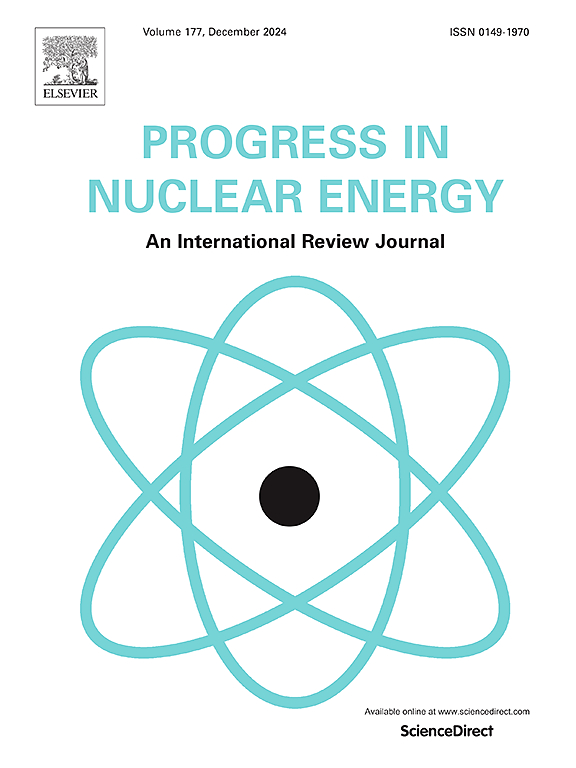Cross-domain fault diagnosis method for nuclear power plant bearings based on deep transfer learning under small sample conditions
IF 3.3
3区 工程技术
Q1 NUCLEAR SCIENCE & TECHNOLOGY
引用次数: 0
Abstract
In recent years, methods based on deep learning have attracted attention in the fault diagnosis of rotating machinery in nuclear power plants (NPPs). However, these methods are typically developed under the assumption that sufficient fault samples are available. In practice, rotating machinery in NPPs operate in healthy state most of the time and faults occur rarely and last a relatively short period of time. This work proposes a fault diagnosis method based on deep transfer learning to overcome the issue of small sample conditions in the bearing fault diagnosis task of NPPs. The bearing vibration signals collected by the sensor are converted into a time-frequency map by synchrosqueezed wavelet transforms, they are used as input of the deep convolutional neural network. In the learning phase, the deep learning model first learns domain-related knowledge from real devices, then the model parameters are transferred to the target task, and the model is fine-tuned based on the target domain knowledge. The proposed method was applied to two case studies: bearing fault localization and fault severity assessment. Experimental results demonstrated that, for the fault localization case, the method achieved average accuracy, precision, and F1 score of 95.21 %, 95.35 %, and 95.17 %, respectively, under four small sample conditions (with 10, 20, 30, and 40 samples per category in the training dataset). For the fault severity assessment case, the method attained average accuracy, precision, and F1 score of 95.03 %, 95.45 %, and 94.94 %, respectively, under three small sample conditions (with 3, 5, and 8 samples per category in the training dataset), demonstrating its potential value for NPPs bearing fault diagnosis.
小样本条件下基于深度迁移学习的核电厂轴承跨域故障诊断方法
近年来,基于深度学习的方法在核电站旋转机械故障诊断中受到了广泛关注。然而,这些方法通常是在假设有足够的故障样本可用的情况下开发的。在实际运行中,核电站旋转机械大部分时间处于健康运行状态,故障很少发生,持续时间也相对较短。本文提出了一种基于深度迁移学习的故障诊断方法,克服了核电厂轴承故障诊断任务中样本条件小的问题。通过同步压缩小波变换将传感器采集到的轴承振动信号转换成时频图,作为深度卷积神经网络的输入。在学习阶段,深度学习模型首先从实际设备中学习领域相关知识,然后将模型参数传递到目标任务中,并根据目标领域知识对模型进行微调。将该方法应用于轴承故障定位和故障严重程度评估两个案例研究。实验结果表明,对于故障定位案例,该方法在四种小样本条件下(训练数据集中每个类别分别有10、20、30和40个样本)的平均准确率、精密度和F1分数分别达到95.21%、95.35%和95.17%。对于故障严重性评估案例,该方法在三种小样本条件下(训练数据集中每个类别分别有3、5和8个样本)的平均准确率、精密度和F1分数分别为95.03%、95.45%和94.94%,显示了其在核电厂轴承故障诊断中的潜在价值。
本文章由计算机程序翻译,如有差异,请以英文原文为准。
求助全文
约1分钟内获得全文
求助全文
来源期刊

Progress in Nuclear Energy
工程技术-核科学技术
CiteScore
5.30
自引率
14.80%
发文量
331
审稿时长
3.5 months
期刊介绍:
Progress in Nuclear Energy is an international review journal covering all aspects of nuclear science and engineering. In keeping with the maturity of nuclear power, articles on safety, siting and environmental problems are encouraged, as are those associated with economics and fuel management. However, basic physics and engineering will remain an important aspect of the editorial policy. Articles published are either of a review nature or present new material in more depth. They are aimed at researchers and technically-oriented managers working in the nuclear energy field.
Please note the following:
1) PNE seeks high quality research papers which are medium to long in length. Short research papers should be submitted to the journal Annals in Nuclear Energy.
2) PNE reserves the right to reject papers which are based solely on routine application of computer codes used to produce reactor designs or explain existing reactor phenomena. Such papers, although worthy, are best left as laboratory reports whereas Progress in Nuclear Energy seeks papers of originality, which are archival in nature, in the fields of mathematical and experimental nuclear technology, including fission, fusion (blanket physics, radiation damage), safety, materials aspects, economics, etc.
3) Review papers, which may occasionally be invited, are particularly sought by the journal in these fields.
 求助内容:
求助内容: 应助结果提醒方式:
应助结果提醒方式:


